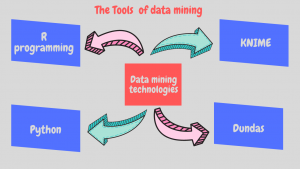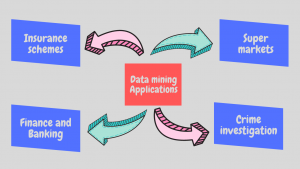Data mining
What is data mining?
In computer science , data mining, also called information exploration in databases, is the method of finding important and enjoyable patterns and relationships between quantities of data. The area blends analytics and artificial intelligence tools (such as machine learning and data science) with central database maintenance to evaluate massive collections, or data sources. Data mining is commonly used in industry (premiums, banking , retail), scientific (astrophysics, medications) education, and legal protection (violent terrorist identification).
How data mining works.
The process of extracting data falls down into different stages. Secondly , companies are gathering data and loading these into the data centers. First, they archive and process the data, in either-house or web server. The methodology used to implement data analysis is called simulation. Modeling is essentially the process of constructing a model based on data from situations where the response is established (a variety of labeled or a performing mathematical) and then extending the framework to other circumstances where the responses are not established. Modeling techniques have been around for decades, for example, but this is only recently that storage capacity and communication capacities needed to collect and process massive quantities of data have become available, and the computational resources to allow materials used in the product to operate immediately on the data. The data mining process begins in various stages from collecting and handling results in various groups to analyzing and displaying data through graphs: collecting, transforming and loading interaction data into the data warehouse network. Store and control data in a multifaceted database system and allow business analysts exposure to data. Some companies would choose to subcontract data mining capabilities to the professional team in order to make the most of the raw data from industry. The effective way to boost operational efficiency is to collaborate with both the correct outsourcing partners so start exploring one for someone’s business & obtain advantages.
The Tools and application of data mining.
Data mining is finding a secret, real, and all promising candidate trends in data sets of large sizes. Data mining is a method that lets you identify undiscovered/undiscovered interactions amongst these companies.

Figure 1. Tools of Data mining
There are several valuable technologies available.
- R-Programming: R is a Statistical Computing and Visual language. It also is used only for analyzing large amounts of data. It offers a broad array of statistical measures. Good data storage and processing facility. It offers a series of operations, especially matrices, for measurements on arrays. It presents a cohesive, streamlined range of data processing resources for Big Data. It spectacularly views data analysis services that view whether on-screen or hard-copying.
- Python: Python is most commonly related to R as a free open source tool that can be accessed and stored on the computer for convenience of the use. Unlike R, the learning process of Python seems to be so quick it’s becoming famous. Many people found that in hrs they can actually build sets of data and perform highly complicated affinity assessment, trying to make this an incredibly efficient and effective tool for data mining. The most prevalent case-data visualizations for business use will be simple and clear so lengthy as you are satisfied with basic programming concepts such as variables , data kinds, operations, conditional expressions and loops.
- KNIME: Konstanz Data Miner is a forum for the study of open-source data. Through this, information can be deployed, scale-up, and acquainted within no time. KNIME is recognized in the traditional business intelligence environment as the framework which actually makes quantitative intelligence available to novice users. The data-driven research & development is also helping to discover the data capacity. This also provides upwards of hundreds of ready-to-use applications and illustrations and a variety of advanced software and algorithms.
- Dundas: Dundas is a data analysis platform designed for the business that can be used to create and display virtual analytics, documents, etc. You may install Dundas BI as the organization’s main information center. Server framework with full functionality of the software. Integrate and view all types of data resources and visualization tools of personalized data. It provides Effective tools for dragging and falling and mapping data like statistical and specialized data collection.
Challenges.
While data mining is quite efficient, its deployment faces numerous difficulties. The challenges may be efficiency, data, strategies, and procedures of primary reason. The data mining is effective when the issues or problems are correctly identified and neatly categorized out. Data mining is the method whereby information is extracted from large amounts of data. The evidence about the natural world is heterogeneous, inconsistent, and noisy. Typically, data in large amounts may be imprecise or inconsistent. These issues may be due to computer errors calculating the data or human errors. Suppose a supermarket chain gathers customers’ email ids that spend more than $200, and the billing staff brings the data into their process. The person can make spelling errors while inserting the email Id which leads to incorrect data. Also, some clients may not be ready to reveal their email I d resulting in incomplete data. Even machines or mistakes may alter the data. Both of these results in chaotic and insufficient information which really renders data mining difficult.
Applications of data mining:
- Insurance schemes: Data mining lets insurance firms make competitive rates for their goods and sell new deals to potential current clients.
- Finance and Banking: It lets the finance industry get a snapshot of business risks and monitor compliance with regulations. It’s helping banks recognize.
- Super Markets: It enables the creation of guidelines for supermarkets to forecast when their shoppers are likely to be predicted. By analyzing their purchasing behavior, they were able to identify clients of women who are the most probably pregnant. We will begin targeting items such as baby wipes, baby stores, diapers, etc.
- Crime Investigation: Data mining can help criminal investigation departments implement police workers (when and where is indeed a homicide most expected to happen), who’s really searching at an international border etc.

Figure 2. Applications of Data mining
Future of data mining:
For data mining and data engineering the future looks looking because the amount of data is really only going to increase. The cumulative digital information universe is expected to rise from 4.4 zettabytes to 44 zettabytes by 2020. We’ll also generate 1.7 megabytes of new knowledge for every human being on earth every second. Just as mining algorithms have developed and improved due to technological changes, so too have technology for extracting useful insights from data. Once upon a time, only organizations like NASA were able to use their supercomputers to analyze data. The cost of data storage and computation was just too high. Today , businesses of cloud-based data centers are doing all kinds of fascinating events with machine learning , artificial intelligence and neural networks.